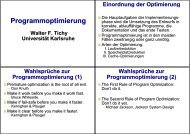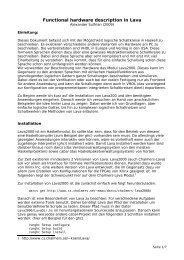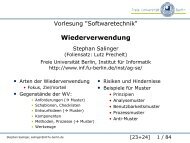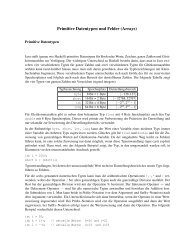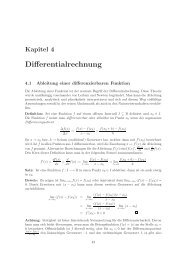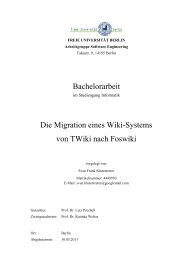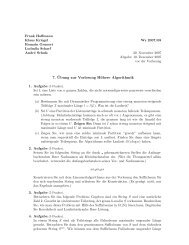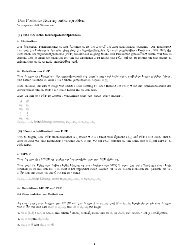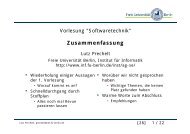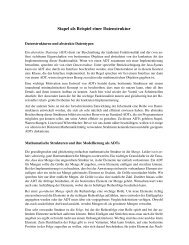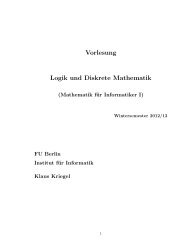9. Extending the Relational Model: - SQL 99 –
9. Extending the Relational Model: - SQL 99 –
9. Extending the Relational Model: - SQL 99 –
You also want an ePaper? Increase the reach of your titles
YUMPU automatically turns print PDFs into web optimized ePapers that Google loves.
<strong>9.</strong> <strong>Extending</strong> <strong>the</strong> <strong>Relational</strong> <strong>Model</strong>:<br />
- <strong>SQL</strong> <strong>99</strong> <strong>–</strong><br />
<strong>9.</strong>1 Motivation<br />
<strong>9.</strong>2 Collection types<br />
<strong>9.</strong>3 Types and objects<br />
<strong>9.</strong>4 Functions<br />
<strong>9.</strong>5 Triggers<br />
Context<br />
Requirements analysis<br />
Conceptual Design<br />
Schema design<br />
-logical (“create tables”)<br />
Schema design<br />
-physical<br />
(“create access path”)<br />
Part 1: Designing and sing database<br />
Database Design:<br />
- developing a relational<br />
database schema<br />
Design:<br />
- formal <strong>the</strong>ory<br />
Data handling in a relational<br />
database<br />
- Algebra,-calculus -<strong>SQL</strong><br />
Extensions<br />
Using Databases<br />
from application Progs<br />
Physical Schema,<br />
see Kemper/Eickler chap. 14, Elmasri chap. 6.8, O'Neill: Chap. 4,<br />
Postgres manual, Oracle PL/<strong>SQL</strong> manual, Melton: <strong>SQL</strong><strong>99</strong><br />
© HS-2008<br />
Loading, administration,<br />
tuning, maintenance,<br />
reorganization<br />
09-<strong>SQL</strong>Extensions-2<br />
<strong>9.</strong>1 Motivation: Objects<br />
Missing in <strong>the</strong> RDM<br />
Structured attributes<br />
• Compound records<br />
• Vectors, sequences<br />
•Sets<br />
• tables<br />
• Type constructors<br />
Inheritance between relations<br />
• ER generalization and mapping to relations useful<br />
on <strong>the</strong> design level, not as relations<br />
Operations (methods, functions)<br />
Enhancement of <strong>the</strong> RDM?<br />
NO:<br />
Make object oriented language persistent<br />
⇒ Object <strong>Relational</strong> Mapping<br />
(e.g. Hibernate)<br />
YES:<br />
Enhance relational model carefully with object<br />
concepts<br />
⇒ Object <strong>Relational</strong> Data <strong>Model</strong><br />
(<strong>SQL</strong> <strong>99</strong> /2003 , e.g. Oracle, Postgres)<br />
© HS-2008<br />
09-<strong>SQL</strong>Extensions-3<br />
© HS-2008<br />
09-<strong>SQL</strong>Extensions-4<br />
Motivation: OO Languages and DB <strong>Model</strong><br />
Persistent OO Programming Language<br />
Ideally no difference between persistent and non<br />
persistent objects form a programmer's point of view<br />
(Seamless integration)<br />
Persistence is just a feature of Objects<br />
Use OO <strong>Model</strong>ing and design methodology<br />
Issues<br />
• Query language or pointer chasing?<br />
First generation ODBS did not have a query<br />
language<br />
• What about non-object oriented languages?<br />
• Concurrency and transactional support?<br />
Technical solutions<br />
New Data <strong>Model</strong> <strong>–</strong> new Database System<br />
⇒ Object Oriented Database Systems<br />
Very popular in <strong>the</strong> 1<strong>99</strong>0ies:<br />
Object Store, Poet, O2, GemStone, Orion, …<br />
e.g. Object Store, Poet: tight integration with C++<br />
Disadvantage:<br />
Gives up <strong>the</strong> "tabular data abstraction"<br />
• Neutral Data format<br />
• Powerful operation<br />
Mapping of RDB data into program address space<br />
© HS-2008<br />
09-<strong>SQL</strong>Extensions-5<br />
© HS-2008<br />
09-<strong>SQL</strong>Extensions-6<br />
1
Motivation: Objects and Relations<br />
Object <strong>Relational</strong> Systems<br />
Principles:<br />
• Keep <strong>the</strong> goodies of RDB<br />
• Enhance relational systems by constructed types,<br />
inheritance, methods<br />
Supported by <strong>SQL</strong>-3 standard<br />
Issues<br />
• Technologically outdated solutions stabilized<br />
e.g. type system, baroque constructs of <strong>SQL</strong><br />
• Add-on usually worse than completely new approach<br />
Important aspect: Save investment into your software<br />
Overview: <strong>SQL</strong>-<strong>99</strong> (<strong>SQL</strong>-3) extensions<br />
Collection types<br />
SET, Multiset, List constructors for primitive and<br />
constructed types, arrays<br />
e.g. Phones SET (VARCHAR(20))<br />
Polygon LIST (Point_T)<br />
Composite types / objects<br />
Records, objects<br />
Functions / methods<br />
Active elements: Triggers<br />
Big differences between 'object relational' products:<br />
Oracle, DB2, Postgres, <strong>SQL</strong>-Server (V 2005)<br />
© HS-2008<br />
09-<strong>SQL</strong>Extensions-7<br />
© HS-2008<br />
09-<strong>SQL</strong>Extensions-8<br />
<strong>9.</strong>2 Collection types: arrays<br />
Collection types: arrays<br />
<strong>SQL</strong> -3 standard:<br />
CREATE TABLE phone_book (<br />
pid INTEGER,<br />
home VARCHAR(15) ARRAY[5]<br />
mobile VARCHAR (15) ARRAY[3])<br />
Postgres arrays<br />
additional syntax:<br />
[]<br />
more than one dimension<br />
CREATE TABLE chessBord (<br />
board INTEGER [8][8]<br />
Oracle VARARRAYs:<br />
Special case of general type extension<br />
CREATE TYPE Extension_T as VARRAY(4) OF Int;<br />
CREATE OR REPLACE TYPE Address_T AS OBJECT (<br />
zipcode CHAR(6),<br />
city VARCHAR(20),<br />
street VARCHAR(25),<br />
no<br />
CHAR(5));<br />
Type definitions,<br />
see below<br />
CREATE TABLE phone_book (<br />
name VARCHAR(30),<br />
firstName VARCHAR(20),<br />
addr Address_T,<br />
phones Extension_T);<br />
© HS-2008<br />
09-<strong>SQL</strong>Extensions-9<br />
© HS-2008<br />
09-<strong>SQL</strong>Extensions-10<br />
Collection types: arrays<br />
How to update / select arrays?<br />
Postgres syntax for array constants:<br />
e.g ('a','b','d') , ((1,2),(1,2,3,4))<br />
INSERT INTO phone_book VALUES<br />
(11, ('+49-30-4836721', '4398722'),() )<br />
Array constructor: ARRAY [1,3,5,7,9]<br />
also allowed.<br />
Collection types: arrays<br />
Selection<br />
SELECT pid FROM phone_book<br />
WHERE home[1] = '4711348'<br />
?? One of <strong>the</strong> phone numbers should satisfy <strong>the</strong><br />
predicate, not just <strong>the</strong> first.<br />
Postgres solution: IN, ANY/SOME, ALL<br />
set comparisons<br />
SELECT pid FROM phone_book<br />
WHERE '4711348' IN home<br />
© HS-2008<br />
09-<strong>SQL</strong>Extensions-11<br />
© HS-2008<br />
09-<strong>SQL</strong>Extensions-12<br />
2
Collection types: arrays<br />
Arrays are not sets<br />
separate tables are a better design decision for sets<br />
Implementation issues:<br />
Postgres stores array values within rows<br />
⇒ Problems with large number of values<br />
(e.g. measurement REAL [1000] )<br />
Completely different handling of arrays in Oracle<br />
Collection types: arrays (Oracle)<br />
VARRAY defined<br />
INSERT INTO PhoneBook VALUES(<br />
'Abel', 'Hendrik', ADDRESS_T('12347',<br />
'Berlin', 'Takustr.','9'),<br />
Extension_T(2347, 1139));<br />
SELECT b.name, b.addr.street, b.phones<br />
FROM PhoneBook b<br />
WHERE 2347 IN (SELECT * FROM<br />
TABLE(b.phones));<br />
NAME ADDR.STREET PHONES<br />
---------------------------------<br />
Abel Takustr. EXTENSION_T(2347, 1139)<br />
© HS-2008<br />
09-<strong>SQL</strong>Extensions-13<br />
© HS-2008<br />
No way to address by position<br />
e.g. phones[2]<br />
Cast of a varray<br />
to a table<br />
09-<strong>SQL</strong>Extensions-14<br />
<strong>9.</strong>3 Creating new types<br />
Definition of composite types<br />
CREATE TYPE complex AS OBJECT<br />
( r double precision, i double precision );<br />
Nothing but a definition of <strong>the</strong> type of a structured<br />
value ("record type")<br />
Used as a column type in Postgres and o<strong>the</strong>rs<br />
CREATE TABLE Foo (<br />
n VARCHAR(5),<br />
roots complex [2] )<br />
Access to components of a type:<br />
SELECT n, (roots).x FROM Foo WHERE...<br />
Nested tables (<strong>SQL</strong>-3): Oracle flavor<br />
Nested table: definition<br />
Restriction: only one level of nesting<br />
CREATE TYPE Polygon_T AS TABLE OF Point_T;<br />
CREATE TABLE Polygons (<br />
pid CHAR(5),<br />
points Polygon_T)<br />
NESTED TABLE points STORE AS PointsTab;<br />
Stored outside table Polygons<br />
Where Point_t is..<br />
create or replace TYPE<br />
Point_T AS OBJECT (x int, y int)<br />
© HS-2008<br />
09-<strong>SQL</strong>Extensions-15<br />
© HS-2008<br />
09-<strong>SQL</strong>Extensions-16<br />
Nested tables (<strong>SQL</strong>-3): Oracle flavor<br />
© HS-2008<br />
Querying nested tables using inner tables<br />
SELECT t.pid FROM Polygons t<br />
WHERE EXISTS<br />
(SELECT ss.x FROM<br />
TABLE(SELECT points<br />
FROM Polygons t2<br />
WHERE t2.pid = t.pid<br />
) ss<br />
WHERE ss.x = ss.y)<br />
AND pid <strong>99</strong>1;<br />
Additional outer qualification<br />
predicate<br />
Select one row in<br />
polygons and select a<br />
table value (points)<br />
Inner qualification on table value<br />
09-<strong>SQL</strong>Extensions-17<br />
Object <strong>Relational</strong> Concepts: Object types<br />
<strong>SQL</strong>-<strong>99</strong> objects<br />
Row types<br />
A row may be an object which has attributes and can be<br />
referenced<br />
Column types<br />
an (A)DT which may be <strong>the</strong> type of an attribute<br />
© HS-2008<br />
CREATE TYPE AdressType AS OBJECT (<br />
city VARCHAR(30),<br />
zipCode VARCHAR(15),<br />
street VARCHAR (30),<br />
number VARCHAR(5),<br />
country VARCHAR(15)<br />
);<br />
/<br />
09-<strong>SQL</strong>Extensions-18<br />
3
Object <strong>Relational</strong> Concepts: Object types<br />
Object Types, Object Tables and REFs (<strong>SQL</strong>-3, Oracle)<br />
REF types have values, can be seen by user<br />
as opposed to OO languages<br />
CREATE TYPE MovieType AS OBJECT (<br />
mId Int ,<br />
title VARCHAR(30),<br />
director VARCHAR(25),<br />
year date<br />
); /<br />
© HS-2008<br />
<strong>SQL</strong>> CREATE TABLE MovieObjects OF MovieType;<br />
CREATE TABLE MovieDVD (<br />
Id Int,<br />
movie REF MovieType,<br />
since date,<br />
back date<br />
);<br />
Object table<br />
Table with<br />
object reference<br />
09-<strong>SQL</strong>Extensions-19<br />
<strong>SQL</strong>3: Abstract data types<br />
"ADT is a data type defined by <strong>the</strong> operations allowed on its<br />
values"<br />
CREATE TYPE (<br />
<br />
<br />
< declaration of more methods> )<br />
supported only by a few DBS<br />
ADT equivalent to 'object type' (Oracle)<br />
... or functions may be defined stand-alone (PG)<br />
© HS-2008<br />
09-<strong>SQL</strong>Extensions-20<br />
Functions, methods, procedures<br />
Method interface in an object type definition<br />
(Oracle flavor)<br />
CREATE TYPE LineType AS OBJECT<br />
( end1 PointType,<br />
end2 PointType,<br />
MEMBER FUNCTION length(scale IN NUMBER) RETURN<br />
NUMBER,<br />
PRAGMA RESTRICT_REFERENCES(length, WNDS));<br />
CREATE TABLE Lines ( lineID INT, line LineType );<br />
Predicates defined over functions<br />
© HS-2008<br />
SELECT lineID, k.length (1.0) FROM Lines k<br />
WHERE k.length(1.0) > <strong>9.</strong>0<br />
Parameter type:<br />
in, out, in out<br />
09-<strong>SQL</strong>Extensions-21<br />
Defining methods (Oracle)<br />
Implementation of a method signatur*<br />
CREATE TYPE BODY LineType AS<br />
MEMBER FUNCTION length(scale NUMBER) RETURN NUMBER<br />
IS<br />
BEGIN<br />
RETURN scale * SQRT((SELF.end1.x-<br />
SELF.end2.x)*(SELF.end1.x-SELF.end2.x) +<br />
(SELF.end1.y-SELF.end2.y)*(SELF.end1.y-<br />
SELF.end2.y) );<br />
END;<br />
END;<br />
Methods may be defined in Java or PL/<strong>SQL</strong> (Oracle)<br />
Functions: independent of types, no SELF attribute<br />
*compare: java interface vs. class<br />
© HS-2008 see: Ullman, J.: Object-<strong>Relational</strong> Features of Oracle 09-<strong>SQL</strong>Extensions-22<br />
http://www-db.stanford.edu/~ullman/fcdb/oracle/or-objects.html<br />
Type definitions in Postgre<strong>SQL</strong>: : composite<br />
Postgres composite types: Completely different concept<br />
CREATE TYPE point AS ( r double precision, i double<br />
precision );<br />
CREATE TABLE polygons (<br />
pid CHAR(5),<br />
ppoints point[200])<br />
SELECT ppoints[1] AS startPoint<br />
FROM polygons WHERE pid = 'myPoly'<br />
Postgres offers geometric types like point, line,<br />
...<br />
They have been defined using <strong>the</strong> "user defined type"<br />
concept<br />
© HS-2008<br />
No object types:<br />
- no REF,<br />
- no inheritance,<br />
- no methods<br />
09-<strong>SQL</strong>Extensions-23<br />
Type definitions in Postgre<strong>SQL</strong>: : user defined<br />
B. User defined types<br />
... are scalar types<br />
- not composite from <strong>SQL</strong> point of view<br />
Defined as a C structure (typically)<br />
Needed: input and output functions<br />
no general method interface<br />
Example: complex numbers*<br />
typedef struct Complex<br />
{ double x; double y; } Complex;<br />
* see PG manual<br />
© HS-2008<br />
09-<strong>SQL</strong>Extensions-24<br />
4
Type definitions in Postgre<strong>SQL</strong><br />
Input function for user defined data type 'complex':<br />
complex_in(PG_FUNCTION_ARGS)<br />
{ char *str = PG_GETARG_CSTRING(0);<br />
double x, y;<br />
Complex *result;<br />
if (sscanf(str, " ( %lf , %lf )", &x, &y) != 2)<br />
/* parser for input and error handling....<br />
result = (Complex *) palloc(sizeof(Complex));<br />
result->x = x; result->y = y;<br />
PG_RETURN_POINTER(result);<br />
}<br />
Registering as a PG function:<br />
CREATE FUNCTION complex_in(cstring) RETURNS complex<br />
AS 'myComplex.c' LANGUAGE C IMMUTABLE STRICT;<br />
Type definitions in Postgre<strong>SQL</strong><br />
Defining <strong>the</strong> scalar type<br />
CREATE TYPE complex<br />
( internallength = 16,<br />
INPUT = complex_in,<br />
OUTPUT = complex_out, /* output fct<br />
RECEIVE = complex_recv, /* binary input fct(option.)<br />
SEND = complex_send, /* binary output<br />
ALIGNEMENT = double );<br />
Using <strong>the</strong> scalar type<br />
CREATE TABLE foo AS<br />
(...,<br />
val complex,<br />
...<br />
)<br />
© HS-2008<br />
09-<strong>SQL</strong>Extensions-25<br />
© HS-2008<br />
09-<strong>SQL</strong>Extensions-26<br />
Type definitions in Postgre<strong>SQL</strong><br />
Example: Document type<br />
CREATE TYPE document (<br />
INPUT = lo_filein,<br />
OUTPUT = lo_fileout,<br />
INTERNALLENGTH = VARIABLE );<br />
CREATE TABLE myDocuments ( id integer, obj document );<br />
Not very interesting...<br />
.... without operators / functions<br />
Functions may be defined independently<br />
CREATE FUNCTION concat_docs(doc, doc)<br />
RETURNS doc AS 'concat_docs',<br />
LANGUAGE C;<br />
<strong>9.</strong>4 Functions ('stored procedures')<br />
Server extension by user defined functions<br />
defined independent from type / object type defs<br />
<strong>SQL</strong> based: <strong>SQL</strong>/PSM, PL/<strong>SQL</strong> (Oracle), PL/pg<strong>SQL</strong><br />
• adds control structures to <strong>SQL</strong><br />
• easy way to define complex functions on <strong>the</strong> DB<br />
Programming language based<br />
C, Java, ...,Perl, Python, Tcl for Postgres<br />
Any Programming language suitable in principle<br />
Defined in <strong>the</strong> <strong>SQL</strong> 3 standard,<br />
(Some) differences in most systems<br />
© HS-2008<br />
09-<strong>SQL</strong>Extensions-27<br />
© HS-2008<br />
09-<strong>SQL</strong>Extensions-28<br />
<strong>SQL</strong> based function<br />
<strong>SQL</strong> based functions<br />
Example<br />
CREATE FUNCTION foo (acc integer, amount numeric)<br />
RETURNS numeric AS<br />
$B$ UPDATE bank SET balance = balance - amount<br />
WHERE accountno = acc;<br />
SELECT balance FROM bank WHERE accountno = acc;<br />
$B$ LANGUAGE <strong>SQL</strong>;<br />
$ quoting of PG<br />
Table result types<br />
CREATE FUNCTION getfoo(integer) RETURNS SETOF movie AS<br />
$$ SELECT * FROM movie<br />
WHERE m_id = $1;<br />
$$ LANGUAGE <strong>SQL</strong>;<br />
placeholder for parameters<br />
SELECT title, director FROM getfoo(93) AS m1;<br />
- Many <strong>SQL</strong>-statements in one call: performance gain<br />
- value returned: first row of last query result<br />
- Compound result type and table valued functions allowed<br />
⇒ Table valued function in FROM clause<br />
Alias for returned table value<br />
© HS-2008<br />
09-<strong>SQL</strong>Extensions-29<br />
© HS-2008<br />
09-<strong>SQL</strong>Extensions-30<br />
5
PL/pg<strong>SQL</strong><br />
in a nutshell<br />
Example<br />
© HS-2008<br />
CREATE OR REPLACE FUNCTION rand (hi integer,low int4)<br />
RETURNS integer AS<br />
$BODY$<br />
-- no DECLARE<br />
BEGIN<br />
block<br />
RETURN low + ceil((hi-low) * random());<br />
END;<br />
$BODY$<br />
LANGUAGE 'plpgsql' VOLATILE;<br />
$-quote, useful for<br />
string literals<br />
During testing no DROP necessary<br />
Here go <strong>the</strong> variable<br />
declarations<br />
Standard functions:<br />
random() returns<br />
uniformly distributed<br />
values 0
PL/<strong>SQL</strong> declarations<br />
a) Standard declarations<br />
DECLARE<br />
price NUMBER;<br />
myBeer VARCHAR(20);<br />
b) Use types of tables<br />
DECLARE<br />
myBeer Beers.name%TYPE;<br />
a) Use row type<br />
DECLARE<br />
table<br />
column<br />
beerTuple Beers%ROWTYPE;<br />
PL/<strong>SQL</strong> control flow<br />
DECLARE<br />
a NUMBER;<br />
b NUMBER;<br />
BEGIN<br />
SELECT e,f INTO a,b FROM T1 WHERE e>1;<br />
IF b=1 THEN<br />
INSERT INTO T1 VALUES(b,a);<br />
ELSE<br />
INSERT INTO T1VALUES(b+10,a+10);<br />
END IF;<br />
END;<br />
© HS-2008<br />
09-<strong>SQL</strong>Extensions-37<br />
© HS-2008<br />
09-<strong>SQL</strong>Extensions-38<br />
PL/<strong>SQL</strong> Control flow<br />
DECLARE<br />
i NUMBER := 1;<br />
BEGIN<br />
LOOP<br />
INSERT INTO T1 VALUES(i,i);<br />
i := i+1;<br />
EXIT WHEN i>100;<br />
END LOOP;<br />
END;<br />
Similar : WHILE () LOOP ... END LOOP<br />
FOR IN .. LOOP ...END LOOP<br />
see Manual<br />
PL/<strong>SQL</strong> Insertion<br />
create table testNormal (empno number(10),<br />
ename varchar2(30), sal number(10));<br />
Begin<br />
For i in 1..1000000<br />
Loop<br />
Insert into test_normal<br />
values(i, dbms_random.string('U',80),<br />
dbms_random.value(1000,7000));<br />
If mod(i, 10000) = 0 <strong>the</strong>n<br />
Commit;<br />
End if;<br />
End loop;<br />
End;<br />
© HS-2008<br />
09-<strong>SQL</strong>Extensions-39<br />
© HS-2008<br />
09-<strong>SQL</strong>Extensions-40<br />
PL/<strong>SQL</strong> procedures<br />
CREATE PROCEDURE addtuple2 ( x T2.a%TYPE,<br />
y T2.b%TYPE)<br />
AS<br />
i NUMBER = dbms_random.value(1000,7000)<br />
/* here go declarations<br />
BEGIN<br />
INSERT INTO T2(k NUMBER,a, b)<br />
VALUES(i,x, y);<br />
END addtuple2;<br />
No DECLARE section<br />
call by value (IN), call by result (OUT),<br />
call by value-result (INOUT)<br />
© HS-2008<br />
09-<strong>SQL</strong>Extensions-41<br />
Realistic PL/<strong>SQL</strong> (Oracle) example<br />
-- very simple purchase transaction<br />
DECLARE<br />
qty_on_hand NUMBER(5);<br />
BEGIN<br />
SELECT quantity INTO qty_on_hand FROM inventory<br />
WHERE product = 'TENNIS RACKET' --<br />
FOR UPDATE OF quantity;<br />
IF qty_on_hand > 0 THEN -- check quantity<br />
UPDATE inventory SET quantity = quantity - 1<br />
WHERE product = 'TENNIS RACKET';<br />
INSERT INTO purchase_record<br />
VALUES ('Tennis racket purchased', SYSDATE);<br />
ELSE<br />
INSERT INTO purchase_record<br />
VALUES ('Out of tennis rackets', SYSDATE);<br />
END IF;<br />
COMMIT;<br />
END;<br />
/<br />
© HS-2008<br />
09-<strong>SQL</strong>Extensions-42<br />
7
Stored procedures: system architecture<br />
Runtime system of PL/<strong>SQL</strong> (example, Oracle)<br />
DBS Server<br />
PL/<strong>SQL</strong><br />
<strong>SQL</strong><br />
Procedure<br />
PL/<strong>SQL</strong><br />
runtime<br />
system<br />
/client<br />
<strong>SQL</strong><br />
<strong>9.</strong>5 Triggers<br />
Triggers: Event <strong>–</strong> Condition <strong>–</strong> Action rules<br />
Event: Update, insert, delete (basically)<br />
Condition: WHEN < some conditon on table><br />
Action: some operation ( expressed as DML, DB- Script<br />
language expression, C, Java,…)<br />
<strong>SQL</strong><br />
PL/<strong>SQL</strong><br />
PL/<strong>SQL</strong><br />
runtime<br />
system<br />
<strong>SQL</strong><br />
<strong>SQL</strong><br />
Triggers make data base systems pro-active<br />
compared to re-active (and interactive)<br />
Fat / thin client<br />
© HS-2008<br />
09-<strong>SQL</strong>Extensions-43<br />
© HS-2008<br />
09-<strong>SQL</strong>Extensions-44<br />
Triggers: simple example<br />
Basic Functionality<br />
CREATE TRIGGER myTrigger<br />
BEFORE [AFTER] event<br />
ON TABLE myTable FOR EACH ROW { | STATEMENT}<br />
EXECUTE PROCEDURE myFunction(myArgs);<br />
event: UPDATE, INSERT, DELETE<br />
Semantics<br />
Execute <strong>the</strong> function after each event<br />
once for each row changed or once per statement<br />
e.g. per statement: write log-record<br />
per row: write new time-stamp<br />
© HS-2008<br />
09-<strong>SQL</strong>Extensions-45<br />
Anatomy of a trigger (Oracle)<br />
Action<br />
(here:<br />
PL/<strong>SQL</strong>)<br />
© HS-2008<br />
CREATE OR REPLACE TRIGGER movie_DVD_Trigger<br />
INSTEAD OF INSERT ON T_M<br />
FOR EACH ROW<br />
DECLARE m_row NUMBER;<br />
-- local variable<br />
BEGIN<br />
SELECT COUNT(*) INTO m_row<br />
FROM Movie<br />
WHERE m_id = :NEW.mid;<br />
Semantics: trigger for<br />
each row affected<br />
(not only once per<br />
excecuted statement)<br />
IF m_row = 0<br />
THEN RAISE_APPLICATION_ERROR(-20300, 'Movie does not<br />
exist');<br />
ELSE INSERT INTO DVD (DVD_id, m_id) VALUES (:NEW.DVD_id,<br />
:NEW.mid);<br />
END IF;<br />
End; CREATE view T_M<br />
AS SELECT m.m_Id AS mid, DVD_id, title<br />
...<br />
09-<strong>SQL</strong>Extensions-46<br />
Using an INSTEAD OP TRIGGER<br />
Without <strong>the</strong> trigger:<br />
Insert into T_M (mid, DVD_id) VALUES(93,14);<br />
*<br />
FEHLER in Zeile 1:<br />
ORA-01779: Kann keine Spalte, die einer Basistabelle<br />
zugeordnet wird, verändern<br />
Using <strong>the</strong> INSTEAD OF TRIGGER<br />
Insert into T_M (mid, DVD_id) VALUES(93,14)<br />
1 Zeile eingefügt<br />
Insert into T_M (mid, DVD_id) VALUES(<strong>99</strong>,14)<br />
*<br />
FEHLER in Zeile 1:<br />
ORA-20300: Movie does not exist<br />
ORA-06512: in "VIDEODB.MOVIE_DVD_TRIGGER", Zeile 8<br />
ORA-04088: Fehler bei der Ausführung von Trigger<br />
© HS-2008<br />
09-<strong>SQL</strong>Extensions-47<br />
'VIDEODB.MOVIE_DVD_TRIGGER'<br />
Triggers...<br />
... are a powerful DB programming concept<br />
Allow complex integrity constraints<br />
Used in most real-life database applications<br />
Sometimes dangerous:<br />
CREATE TRIGGER myTrigger1<br />
BEFORE INSERT<br />
ON TABLE myTable1 EXCECUTE myfct (...)<br />
-- inserts some record into myTable2<br />
© HS-2008<br />
CREATE TRIGGER myTrigger2<br />
BEFORE INSERT<br />
ON TABLE myTable2 EXCECUTE myfct (...)<br />
-- inserts some record into myTable1<br />
Cycle!<br />
09-<strong>SQL</strong>Extensions-48<br />
8
Summary<br />
Extensions of relational model very popular<br />
<strong>SQL</strong> 3 keeps extensions under control <strong>–</strong> somehow<br />
Object-relational extensions more important than<br />
object oriented database systems<br />
Extensions basically are:<br />
structured types and set types<br />
functions, written in a db script language or<br />
some programming language<br />
active elements: triggers (<strong>SQL</strong> 3) , rules (only PGres)<br />
© HS-2008<br />
09-<strong>SQL</strong>Extensions-49<br />
9





